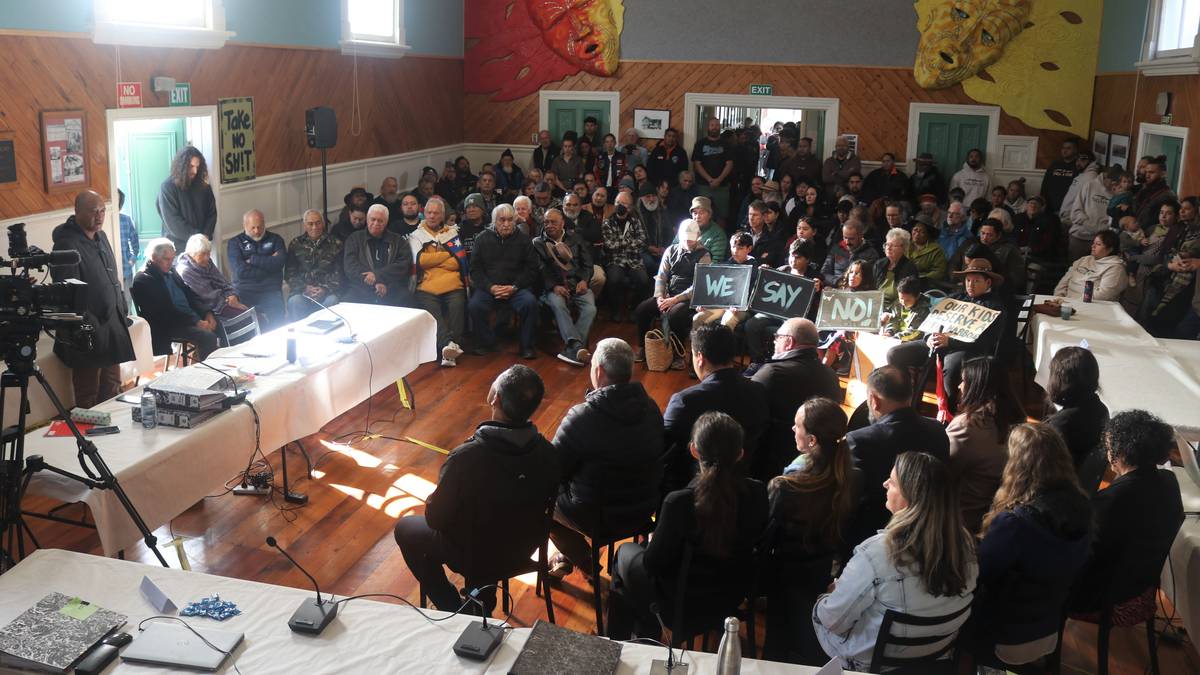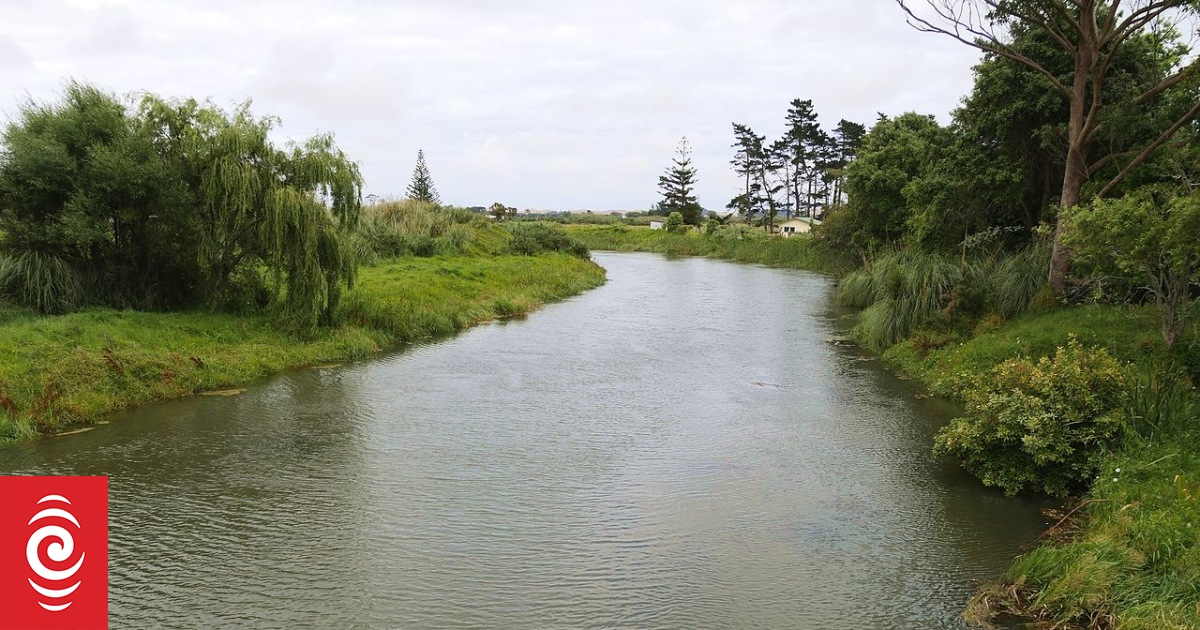Locals rearranged the hearing venue to accommodate a large crowd opposed to the resource consent renewals. Photo / Peter de Graaf
“We’ve had enough” — that was the message loud and clear from Hokianga residents who took over a council hearing in Rāwene to show their opposition to the continued discharge of treated wastewater into the harbour.
Council engineers and managers were to have given evidence on Monday morning at the start of a week-long resource consent hearing for the Ōpononi-Ōmāpere and Kohukohu sewage treatment plants but the locals had other ideas.
The day started with a protest outside Rāwene Town Hall featuring waiata, placards and a banner draped across a hotel across the road demanding “No more teko [poo] in the wai [water]”.
Around 9.30am, when the hearing was due to begin, up to 200 people crowded into the hall with locals bringing in more chairs and rearranging the venue to fit everyone inside. Even then many locals were left standing.
Advertisement
Hokianga kaumātua then gave a series of speeches interspersed with song condemning the discharge of “para” (pollution) and “teko” into one of New Zealand’s most historic and culturally significant harbours.
Schools from as far away as Kaitāia sent student representatives with pupils of Ōmanaia School, in South Hokianga, making oral submissions on Tuesday morning.
Consulting firm Opus is applying, on behalf of the Far North District Council, for a 15-year consent renewal for the Kohukohu wastewater plant. The consent expired in 2016 but the plant has been allowed to keep operating.
The district council is also applying for a 35-year consent renewal for its Ōpononi-Ōmāpere treatment plant. That consent expired in 2019.
Advertisement
Independent commissioners are hearing the evidence and will make a decision on behalf of the Northland Regional Council.
/cloudfront-ap-southeast-2.images.arcpublishing.com/nzme/DAKO2IBP5JASTHFV6CDSWC2U3A.jpg)
Dallas King, spokeswoman for Ngā Hapū o Hokianga and community liaison group Te Mauri o Te Wai, said continuing to discharge wastewater into the harbour from plants that failed any time it rained heavily or got too hot was “totally unacceptable”.
While the main focus was on the discharge to water — hapū wanted the treated effluent discharged to land instead — the treatment method itself was dated, unsuited to the climate and not very good even in its day, he said.
Technology had come a long way since the plants were built in the 1970s-90s, King said.
“There are alternatives now that meet our cultural needs, clean wastewater better, and are more affordable. We can’t continue to do this. It’s not a Māori issue, it’s a humanity issue. Nobody wants human effluent in the water.”
/cloudfront-ap-southeast-2.images.arcpublishing.com/nzme/FPNTREBLKZEBDI6KWGOAEK2C2A.jpg)
Among those taking part on Monday were two of the original submitters against the 1982 sewage plant consents — kaumātua John Klaricich and educator Janine McVeagh.
McVeagh said the last time she saw the community take over a public hearing was in 1976 when the closure of Rāwene Hospital was proposed. On that occasion, the community won.
Monday’s protest had been building up for a long time, she said.
“It’s the culmination of 40 years of people saying the same thing.”
/cloudfront-ap-southeast-2.images.arcpublishing.com/nzme/AOD47YMDUFEHLM2FZYVVSKEEEY.jpg)
Cyril Chapman, of North Hokianga, said it was time for hapū to take a stand.
Advertisement
“We’ve had enough. There are treatment systems that are available now that work. For a long time responsibility has been left to the regional council but just about every waterway is polluted. If that’s an indicator of their kaitiakitanga [guardianship], I think it’s time for us to take back our responsibility as kaitiaki of this land.”
Thirteen-year-old Aio Chapman, of Te Kura Kaupapa Māori o Te Rangi Aniwaniwa, said she came to the hearing to stand up for her hometown, protect the ocean and ensure the water was safe.
“I think they’ll listen. They’d better,” she said.
/cloudfront-ap-southeast-2.images.arcpublishing.com/nzme/A3BE7ZBNCZHC3POZ2VJ4KDNXQQ.jpg)
Treatment plants at Kaikohe and Rāwene also discharge treated wastewater into the Hokianga Harbour.
The hearings will continue until Friday.
Tuesday afternoon was set aside for site visits while Wednesday’s speakers would include marae representatives, community groups, Rāwene residents and Northland’s Green Party candidate.
Advertisement
/cloudfront-ap-southeast-2.images.arcpublishing.com/nzme/KI53B7SHPJBELNGSAONGTXBVJI.jpg)
The Advocate asked the Far North District Council if land-based wastewater disposal was a viable option but did not receive a response by edition time.
The resource consent application for the Ōpononi plant, however, states studies in 2011 and 2014 found the area’s poor-draining soils meant treated wastewater would have to be spread over a large area to ensure there was no runoff.
During rain the ability of poor-draining soil to absorb treated wastewater was minimal so effluent would have to be stored on wet days.
Those problems were compounded by steep terrain near the treatment plant because that increased the risk of runoff.
Flat sites were identified around Pakanae, Waimamaku and Koutu Loop but building pipes to get the wastewater there would be costly.
The set-up cost of land disposal was estimated to be about $2.5m-$5m with operational costs of $200,000-300,000 per year.
Advertisement
The 2014 report concluded land disposal was the preferred option but was not affordable.




